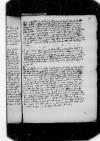Ista hora mihi sunt redditae ⌊⌋ Maiestatis Vestrae Serenissimae Cracoviae 1527-03-02⌊2 Martii1527-03-02⌋ datae per ⌊Fuccaros⌋ mihi missae et subinde, cum illas legerem, nuntiavit mihi ⌊Welzerorum⌋ hic factor, si scribere velim, hodie post prandium se postam per ⌊Gallias⌋ ad ⌊urbem⌋ expediturum, idque valde opportunum mihi evenit, tempus tamen scribendi breve reliquum est, qua de re Maiestas Vestra Serenissima pro sua in me clementia celeritati dabit veniam.
⌊⌋ ⌊hinc⌋, postquam manus mea paulisper melius habere coepit, 1527-04-22⌊22 Aprilis1527-04-22⌋ et ⌊⌋ 1527-05-06⌊6 Maii1527-05-06⌋ ac ⌊⌋ 1527-05-21⌊21 Maii1527-05-21⌋ festinanter et cursim fere omnia, quae tunc se offerebant. Hoc ad praesens etiam facere cogor. Ex iis meis novissimis abunde intellexit, quomodo negotium de adoha habeat, de quo mihi nunc iterum Maiestas Vestra Serenissima scribit. A die 1527-04-16⌊16 Aprilis praeteriti1527-04-16⌋ usque ad hanc ferme horam sollicitare non desii et pridie iterum fui apud ⌊caesarem⌋ et finem istius expeditionis efflagitavi exhibens illi rursus aliud memoriale seu, ut vocant, supplicationem acrius quam primum, atque institi totis viribus rogando, ut Maiestatem Vestram Serenissimam in iis iuribus praerogativis et consuetudinibus ad quas illam per investituram suam admississet, conservaret, in quibusque illustrissimae olim dominae ⌊matri suae⌋ legitime successisset et illa usque ad extremos vitae suae dies in eisdem per suam maiestatem et praedecessores reges habita et libere conservata fuisset. ⌊Maiestas sua⌋ humaniter mihi respondit, quod memoriale meum velit perlegere atque bene apud se perpendere et quicquid sibi esset possibile ea in re, pollicebatur se, quantocius posset, facturum. Idem mihi etiam superiori die, cum ⌊ei⌋ de nato ⌊filio⌋ nomine ⌊regiae⌋ et Reginalis Maiestatis Vestrae congratularer, respondit. Nihil tamen hucusque factum est neque, ut suspicor, quemadmodum etiam in novissimis scripsi, ⌊maiestas sua⌋ quicquid faciet, donec a ⌊vicerege⌋ seu ⌊collaterali consilio ex Neapoli⌋ instructionem habeat desuper, quicquid facere debeat. Ulterius rem non possum promovere omnibus nervis intentis, etiam si creparem medius. Nihilominus nihil omittam et temptabo omnia, quousque huius rei responsionem habeam.
Decrevi negotium hoc cum sobellis apud ⌊imperatricem⌋ aggredi, sed exspecto adhuc in dies a domino ⌊Scipione de Summa⌋ litteras, quid factum sit aut in quo res adhuc haereat, quandoquidem dominus ⌊Sigismundus Loffredus⌋, qui mecum iis diebus in horto meo saepe convenire solet, consolatur me semper dicens fortassis nihil tale factum, cum frater suus ulterius hac de re non scribat, cui hoc negotium nomine Maiestatis Vestrae Serenissimae maxime incumbit. Ex re capiam consilium et quicquid videbitur in iis agi commodum, non omittam. Domina etiam ⌊imperatrix⌋ adhuc suo puerperio est occupata et non permittitur ad eam accessus, si tamen oportebit, certior factus, quomodo de adoha sit transactum, facile impetrabo, ut ab ea cum quadraginta tribus sobellis intromittar.
Scribit Maiestas Vestra Serenissima, quod abunde per alias suas litteras ⌊⌋ de dato 6 Decembris responderit creditque eas tuto ad me pervenisse, verum alias hactenus non vidi et timeo, ne in istis turbis Italicis et ⌊Romae⌋ excitis sint deperditae. Meas ego omnes, quas ⌊⌋ et quas ⌊⌋ et ⌊⌋ scripsi, per ⌊Welseros⌋ transmisi ad ⌊urbem⌋ et vereor, ne idem cum eis eveniat, et istas non sine periculo transmitto.
Quae ⌊Romae⌋ et in ⌊Italia⌋ his diebus acta sunt, peccatis nostris id, Deo permittente, exigentibus, Maiestati Vestrae Serenissimae non ignotum esse arbitror, cum itaque hinc defluant, non curantur. In ista nova hic ⌊principis⌋ nativitate gaudent omnes fiuntque cotidie fere hastiludia choreae et cetera id gaudiorum genus, neque adhuc, quid de pace sperare debeamus, sciri potest. ⌊Turca⌋ fertur esse mortuus et ⌊puerum⌋ octo annorum reliquisse successorem, item ⌊Sophi⌋ cum ⌊Persis⌋ turbas in ⌊Syria⌋ excitasse, ⌊Damascum⌋ et Leptam accepisse et moliri ulterius. Hinc omnia hic secura creduntur, nulla de iis magis cura habetur. Dicuntur etiam huc venire oratores ⌊regis Christianissimi⌋ et ⌊Angliae⌋, qui summam pacis vel belli ulterioris in sinu sunt allaturi feru<n>turque his novis perculsi ⌊Baionae⌋ in finibus ⌊Franciae⌋ substitisse. ⌊Caesar⌋ hinc, ut dicunt, post unum mensem versus ⌊Toletum⌋ est iturus, ut ibidem ⌊Don Philippo⌋ principi Hispanorum filio suo regnum ⌊Castiliae⌋ iuret, postea versus ⌊Valentiam⌋ in ⌊Aragoniam⌋ profecturus hocque in summis caloribus. Calores formido, quos tamen hucusque non habuimus hoc tempore hic alios, quam ut in ⌊Polonia⌋ esse solent. Adeo sunt mutata tempora, ut non satis omnes possint demirari.
Quomodo baptismus istius novi ⌊principis⌋ et pompa eiusdem facta sit, mitto Maiestati Vestrae Serenissimae translatum ex Hispano in Latinum. Fuit in eo baptismo inter compatres contentio, quod boni ominis esse nequit. Tanta est istorum hominum hic superbia, quod unus alteri non cedit neque in eo hic ordo habetur, quem quisque locum hic occupat, mordicus tenet. Vidi 1527-06-16⌊heri1527-06-16⌋ in festo Trinitatis, cum ⌊caesar⌋ iret ad missam in ecclesiam mihi vicinam, ⌊ducem de Besera⌋ tenere dextrum latus caesaris et ⌊archiepiscopum⌋ sinistrum, qui alias semper praecedere solebat, vereorque, ne aliquando pestis ex ⌊Germania⌋ huc transvolet. Sintque bona istius rei principia, siquidem disputatur passim et sunt hic 15 doctores theologi vocati, qui decernere debent, si opera ⌊Erasmi Roterodami⌋ hic legi debeant nec ne, monachi enim operibus Erasmi plurimum adversantur. ⌊⌋ per ⌊Erasmum⌋ editum in Hispanum sermonem per episcopos non contradicentes ⌊⌋ passim ab omnibus legitur, in quo multa contra caeremonias sunt, inde alia sensim subsequentur.
Et cum hoc tempore serenissimae regiae maiestati scribere non possum, mitto Maiestati Vestrae Serenissimae exemplum brevis apostolici, quod huc ⌊pontifex⌋ ante adventum ⌊Borbonensem ducem⌋ ad ⌊urbem⌋ ⌊caesari⌋ transmisit. Ex eo, quomodo res nostri orbis tractentur, liquido intelliget.
Alia pro hac temporis angustia non restant, quam quod me ⌊serenissimae regiae⌋ et Reginali{s} Vestrae Serenissimae Maiestati suppliciter commendo et maximopere rogo, ut reditus mei, quem in gratiosum arbitrium Maiestatum Vestrarum adhuc repono, clementem aliquando rationem habeant.


